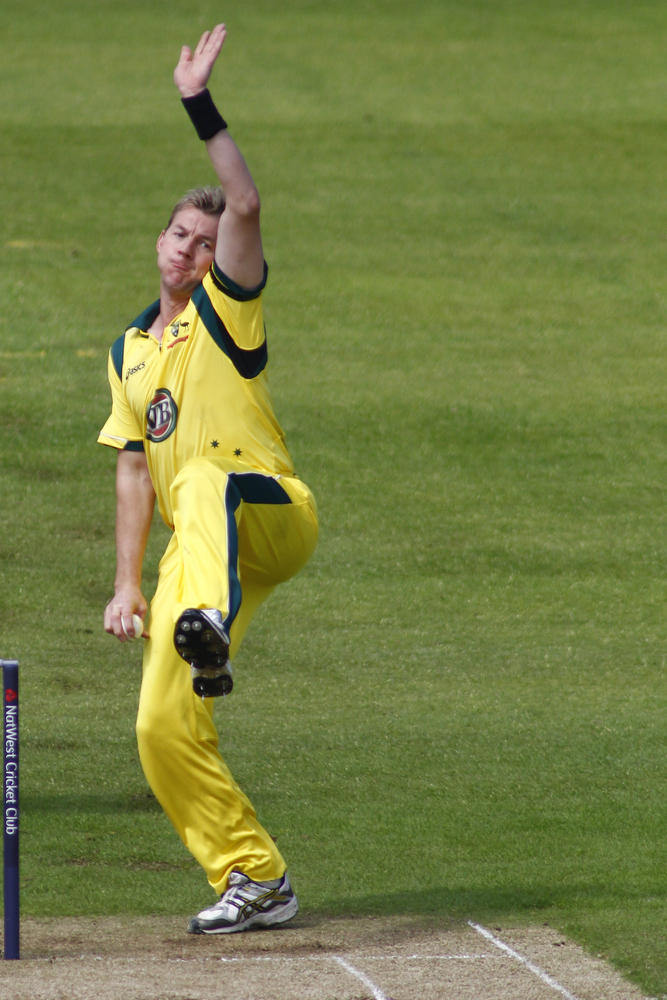|
Research into fast bowling has revealed two simple changes to your action goes 50% of the way to top bowling speed.
Forget about "hip drive", "chest drive" and "pulling your non-bowling arm in": It's all about the feet and legs at the crease. This simple knowledge, which so far has been ignored by coaches, can be turned to your advantage.
You see, coaches sometimes forget that our world is ruled by the laws of physics. As a result, we have simply guessed why some bowlers are quicker than others without any physics to back up their assertions. It becomes pot luck if a bowler can deliver at pace. This situation is unique to cricket: no other sport has such a lack of understanding of the physical principles which govern their discipline.
Until now.
Because I'm going to show you the results of my extensive research into the physics of throwing and the anatomy of the human body. Fast bowling should be surprisingly simple and can be taught to anyone who has the dedication to stick at it.
What has physics got to do with fast bowling?
There are three concepts that govern fast bowling. Good technique allows you to successfully perform all three in the correct order. The good news is that good technique is very easy to understand.
First let's look at the three concepts:
- The generation of 'kinetic energy' in the run-up. In a human body, kinetic energy (think of it as movement energy) arises from the contraction or shortening of muscles. These muscles are fuelled by chemical energy stored in the body.
- The stretching of elastic tissue prior to delivery. Like an elastic band, the muscles store 'elastic' potential energy. This stored energy allows the muscles to return explosively to their original length. Correct technique will allow us to use these stretched tissues to speed up our bowling
- The efficient transfer of energy to the ball. An efficient bowler uses the kinetic energy generated from his run-up and transfers it to the ball by using correct technique. This is ultimately an issue of controlling the energy to take it where it is wanted; in other words, the ball.
These points form the backbone of good bowling: We must run in to create kinetic energy, move our body in such a way as to put our muscles on stretch and then allow that kinetic energy to be transferred from our legs to the ball. There are two things to note about these points:
- Each leads naturally onto the next.
- Poor execution of one will dramatically affect your ability to perform the next.
For example, many club bowlers run in fast but cannot transfer the kinetic energy they have generated to the ball. Many club bowlers also fail to put their muscles on stretch. This means they are not bowling as fast as they could.
Use your legs to bowl faster
What gels the three elements together to make the complete product is a combination of technique, power and flexibility. Although equally important, today we will look at two simple technical points.
Here is what the legs must do.
After the bound, the back leg should land and bend at the knee. This allows you to conserve your run-in energy through the back-leg landing. Imagine that the cricket field is a scale; your back foot landing should make the reading on the scale as small as possible. It looks like this:

On the other hand, the front leg must be as straight as possible. This action stops a huge proportion of the straight line speed of the bowler, but by the 'conservation of energy', this kinetic energy is transferred to the upper body.That looks something like this:

'Conservation of energy' is simply the idea that energy will stay constant. For example when two balls hit each, energy is transferred from one ball to the other, but the total energy of both the balls stays constant. As a fast bowler you are keeping your front leg straight to transfer the energy from your legs to your upper body (and eventually the ball).
By doing this with your legs, you set yourself up to bowl ridiculously fast.
We are not going to "push off" our back leg onto the front leg. The reason is that pushing off requires you to register that you’ve pushed off. By the time your brain has told you that you’ve pushed off, it’s already too late: you’ve lost your run-in energy.
All we want to do on back foot landing is to allow our energy to keep on travelling towards the batsman until our front foot lands. We then want to decelerate as rapidly as possible, which is achieved by the braced front leg.
Want proof?
Watch a long jumper. They don’t push off the board; they just allow their run-in energy to propel themselves through the air.
By positioning your legs in this way you won't want to follow through much at all. If you feel like you have to follow through right down the pitch, it is clear that you are not transferring run-in energy to your upper body very well. In other words, you need to practise keeping your front leg straighter.
While much of bowling is an art, there is definitely a very important place for science in cricket. I hope that with time, we will all be able to improve the quality of the cricket we play by accepting a little bit of physics into our lives.
This article was a guest post from Tom Matcham, Mathematics student at Imperial College, London with a keen interest in Biomechanics and Sports Science.
Discuss this article with other subscribers
|

.jpg)




.jpg)


